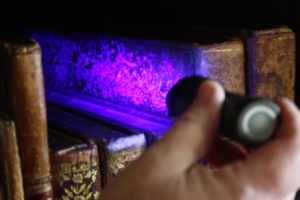Mould is unfortunately a very common problem in book collections. It often manifests itself as fluffy white growth on the outside of a binding or on the edges. Mould occurs when airborne fungi spores settle on a surface in still air. This is why you often find it in environments which are in effect a micro-climate with little air-circulation and a high relative humidity (such as closed bookcases). The spores can be inactive for a long time, until the climate is favourable: within a temperature range of 10 to 35 degrees Celsius (the warmer the better) and a high relative humidity (RH) of over 65%, combined with organic material, mould spores will thrive! Mould is also regarded as a health hazard and suitable precautions need to be taken when handling objects affected by it. Serious outbreaks of mould should be treated by trained professionals.
Mould can often be discovered by the naked eye, but usually it is only by shining a raking light over the surfaces that the full extent of the outbreak becomes clear. UV-light tends to be a good tool, although using a simple LED-torch will also work.

Shining a raking light with a UV-torch shows up the extent of the mould growth on the back cover of this folio
Cloth and leather bindings are generally more susceptible to mould outbreaks, although it can sometimes also be found on paper, such as on the edges of a text block (usually because of dust). As with the prevention of insect damage, maintaining a stable environment (as cool as possible) and a RH below 65% is important. Storing books away from external, north-facing, walls is sometimes a good idea, and ventilating areas containing books helps to improve air-circulation. The books in these images were found in the Library at Kedleston Hall, where the collection is kept in historic, Robert Adam designed, book cases. Although these are beautiful pieces of furniture, they do not necessarily provide the best environment for these books. Because the collection is monitored frequently, the mould outbreak was discovered before it had spread to too many books. It was also limited to two book cases which are placed against exterior walls.
Early in February 2014, I assisted Ian Beaumont, a leather conservator, with cleaning these books. In the next post I will talk a bit more about the procedures for treating mould-infested books.
Sources:
- R.E. Child, Mould (London: Preservation Advisory Centre, 2004, revised 2011) [http://www.bl.uk/blpac/pdf/mould.pdf]
- The National Trust, Manual of Housekeeping (London: Butterworth-Heinemann, 2006), chapters 8 (Biological agents of deterioration) and 42 (Books)


Pingback: Pests and other book related misery (3): getting rid of mould | Behind the Spines